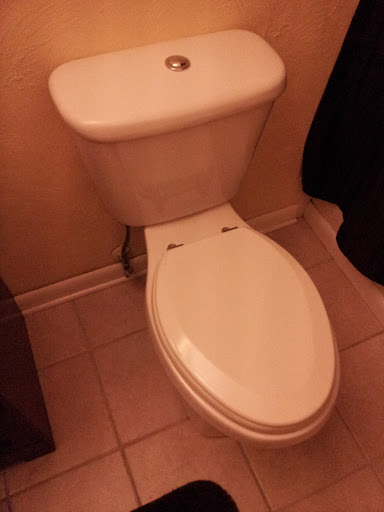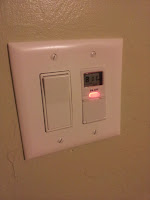During my trips to Scotland in 2007 and 2009, I noticed that almost every private toilet (meaning the ones in people's homes rather than the ones in the basement of the pubs) were
dual-flush. Now that I'm grown-up and I Can Do Whatever I Want
TM, I can't think of any reason
not to rip out my traditional toilet and replace it with something smarter.
 |
| The old flusher. I believe it was made for elves. Short, shallow, and worst of all--inefficient! |
First, a Little Math
What are the savings here? I know I will be using less water, and any amount of savings is good. The old flusher isn't marked, but because it is such a diminutive toilet, we'll assume its 1.6 gallons per flush (gpf). This would already be considered a
low-flow toilet--we've come a long way since the first half of the 20th century, when each flush was ~7 gallons!
The new
dual-flush toilet is, natually, dual-rated. Each "2" flush is 1.6gpf, and each "1" flush is 1.1gpf--meaning that each time I use the "1" flush, I'm saving a half gallon of water.
For the sake of calculation, we'll assume that I flush the toilet once in the morning before work, and three times in the evening/night. Naturally, this figure will change from day-to-day, and as guests appear and disappear. These numbers will suffice for practical demonstration.
Old Toilet: 4 flushes/day @ 1.6gpf x 365 days/year = 2336 gallons.
New Toilet: [(3 flushes/day @ 1.1gpf) + (1 flush/day @ 1.6gpf)] x 365 days/year = 1788.5 gallons.
This makes a difference of 547.5 gallons per year! Keep in mind, this presumes the most conservative figure (1.6gpf) for the old toilet. Your mileage will vary, and depending on the vintage of your toilet and its usage, you may be positioned to save many more gallons a year than I will. Some figures I've read on the internet indicate that I may be already lower than
the average home, which is 5 flushes
per person per day.
 |
| The new hotness. This is an Aquasource high-efficiency toilet. I purchased it from Lowes in Gainesville. |
Why Save Water? What am I saving?
At 547.5 gallons a year, I may save between $12-36/year. My utility company's water rates are structured so that the more I consume, the greater the cost per KGAL (1000 gallons). Naturally, if I use less water, I am more likely to fall into the lower cost bracket--and that can make a serious difference in my bill.
Science--specifically the
first law of thermodynamics--tells me that matter and energy cannot be created or destroyed. No matter how hard I try, I won't be able to destroy the Hydrogen and Oxygen that make up our water supply. So, what's the big deal?
Suffice to say that a great deal of energy goes into
supplying water to our homes. Costs include drilling and maintaining wells, pumping, and treatment/purification. The actual calculation is beyond the scope of this journal, but it takes little imagination to see that there is a great utility machine at work to bring water to the toilet tank. Even easier to see is the great deal of energy that goes into that machine.
Saving water doesn't just save you money on your bill--it saves a great deal of energy, effort, and expense further up the chain.
Replacing a Toilet
Replacing
a toilet is not exactly trivial, and not for those with a weak stomach. In toilet plumbing, the u-bend that keeps sewer gasses in the sewer and
not in your bathroom is built into the toilet (rather than the drain below it, like in your kitchen sink). So while you are working, the toilet drain will be exposed. You can stuff an old rag in the opening to keep the sewer smell at bay.
In addition to the toilet, you will need a replacement wax ring and some basic tools--screwdrivers, wrenches, pliers, and perhaps a putty knife to clean off the old wax. Wax rings come in shorter varieties (for flanges at or above floor-level) or taller (for flanges below floor-level) Many wax ring kits will also include replacement floor bolts, and this is a good time to replace those as well.
A word of caution: Once the new toilet is set in place, tighten the floor bolts gingerly. Often, the flange in the floor (against which the floor bolts tighten) is PVC and is as old as the house. Over-tightening the floor bolts can cause the flange to break. If that happens, this task becomes more costly and much harder to finish!
It is challenging to classify the difficulty of this task, since it highly depends on an individual skill and comfort level. This task was easy for me because I have previously learned to replace a toilet and have done so on many occasions. If you have never replaced a toilet before, this task will be more difficult, so it may behoove you to have an experienced friend or family-member on hand to lend some wisdom.
Additionally, the internet is full of c
omprehensive guides on how this is done, so I won't attempt to detail the process here. If you have any doubts at all, you can support your local economy by hiring a
plumber near you to make the swap.
Alternative: Convert Your Existing Toilet
Perhaps
you really like your existing toilet, or you're not prepared to spend the money or time? Or the task is a bit outside of your comfort zone? Your local home-improvement store may be able to sell you a
dual-flush conversion kit for ~$30.
I used one of these kits--with the blessing of my landlord--in the apartment where I lived before buying the
Gainesville Green House. The skills required are the same as those required for replacing the components inside the tank--just a bit harder and requiring a few more tools than replacing the flapper. Consult the included instructions, and if you have any doubts, get some help! There is nothing worse than having a dysfunctional toilet--especially for those of us with only one bathroom!
Older Toilets: Reduce the Flushable Water Volume
If you can't replace your old toilet, and converting to dual-flush isn't an option, there is still something you can do. Improve your bathroom water consumption by adding a half gallon plastic container to the tank and
reduce the volume with
each flush.
--
Happy Greening!
Andy



















